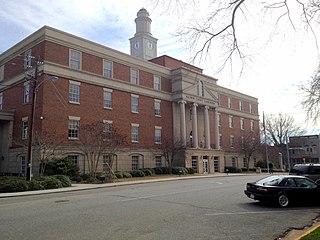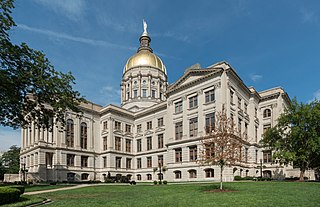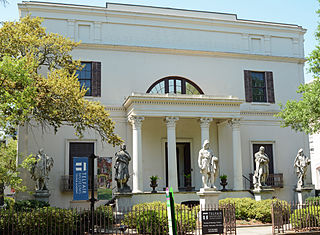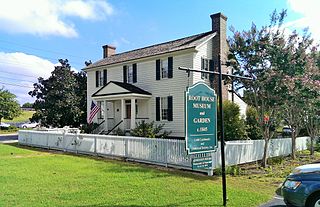
Baldwin County is a county located in the central portion of the U.S. state of Georgia. As of the 2010 census, the population was 46,337. The county seat is Milledgeville, which was developed along the Oconee River.

Milledgeville is a city in and the county seat of Baldwin County in the U.S. state of Georgia. It is northeast of Macon and bordered on the east by the Oconee River. The rapid current of the river here made this an attractive location to build a city. It was the capital of Georgia from 1804 to 1868, including during the American Civil War. Milledgeville was preceded as the capital city by Louisville and was succeeded by Atlanta, the current capital. Today U.S. Highway 441 connects Milledgeville to Madison, Athens, and Dublin.

The Georgia State Capitol is an architecturally and historically significant building in Atlanta, Georgia, United States. The building has been named a National Historic Landmark which is listed on the National Register of Historic Places. As the primary office building of Georgia's government, the capitol houses the offices of the governor, lieutenant governor, and secretary of state on the second floor, chambers in which the General Assembly, consisting of the Georgia State Senate and Georgia House of Representatives, meets annually from January to April. The fourth floor houses visitors' galleries overlooking the legislative chambers and a museum located near the rotunda in which a statue of Miss Freedom caps the dome.

The Governor's Mansion is the official home of the governor of the U.S. State of Georgia. The mansion is located at 391 West Paces Ferry Road NW, in the Tuxedo Park neighborhood of the affluent Buckhead district of Atlanta.

The Mississippi Governor's Mansion is the official residence of the Governor of Mississippi which is currently Tate Reeves. It is located in downtown Jackson, Mississippi, south of the Mississippi State Capitol, at the south end of Smith Park. Completed in 1841 to a design by state architect William Nichols, it is the second-oldest governor's residence in active use in the nation, and a prominent example of Greek Revival architecture. It was designated a National Historic Landmark in 1975, and was declared a Mississippi Landmark in 1985.

The Homewood Museum is a historical museum located on the Johns Hopkins University campus in Baltimore, Maryland. It was listed as a National Historic Landmark in 1971, noted as a family home of Maryland's Carroll family. It, along with Evergreen Museum & Library, make up the Johns Hopkins University Museums.

Cliveden, also known as the Chew House, is a historic site owned by the National Trust for Historic Preservation, located in the Germantown neighborhood of Northwest Philadelphia. Built as a country house for attorney Benjamin Chew, Cliveden was completed in 1767 and was home to seven generations of the Chew family. Cliveden has long been famous as the site of the American Revolutionary War's Battle of Germantown in 1777 as well as for its Georgian architecture.

Rosalie Mansion is a historic pre-Civil War mansion and historic house museum in Natchez, Mississippi. Built in 1823, it served as the architectural inspiration for a large number of Natchez's grand Greek Revival mansions, and was a major influence on Antebellum architecture in the greater region. During the American Civil War, it served as Union headquarters for the Natchez area from July 1863 on. It was designated a National Historic Landmark in 1989.

The Herndon Home is a historic house museum and National Historic Landmark at 587 University Place NW, in Atlanta, Georgia. An elegant Classical Revival mansion with Beaux Arts influences, it was the home of Alonzo Franklin Herndon (1858-1927), a rags-to-riches success story who was born into slavery, but went on to become Atlanta's first black millionaire as founder and head of the Atlanta Life Insurance Company. The house was designed by his wife Adrienne, and was almost entirely built with African-American labor. The house was declared a National Historic Landmark in 2000, and had previously been declared a "landmark building exterior" by the city of Atlanta in 1989.

The Old Medical College Building is a historic academic building at 598 Telfair Street in Augusta, Georgia, US. It was built in 1835 for the Medical College of Georgia, then and now one of the leading medical schools of the American South. It was declared a National Historic Landmark in 1996 for its sophisticated Greek Revival architecture, and for the role the school played in the establishment of the American Medical Association and the standardization of medical practices.

William Scarbrough House is a historic house in Savannah, Georgia. Built in 1819, and subjected to a number later alterations, it is nationally significant as an early example of Greek Revival architecture, and is one of the few surviving American works of architect William Jay. The house was declared a National Historic Landmark in 1973. It is now home to the Ships of the Sea Maritime Museum, and it has largely been restored to an early 19th-century appearance.

The Telfair Academy is a historic mansion at 121 Barnard Street in Savannah, Georgia. It was designed by William Jay and built in 1818, and is one of a small number of Jay's surviving works. It is one of three sites owned by Telfair Museums. Originally a family townhouse belonging to the Telfair family, it became a free art museum in 1886, and thus one of the first 10 art museums in America, and the oldest public art museum in the South. Its first director, elected in 1883, was artist Carl Ludwig Brandt, who spent winters in Savannah. It was declared a National Historic Landmark in 1976.

Rose Hill Manor, now known as Rose Hill Manor Park & Children's Museum, is a historic home located at Frederick, Frederick County, Maryland. It is a 2+1⁄2-story brick house. A notable feature is the large two-story pedimented portico supported by fluted Doric columns on the first floor and Ionic columns on the balustraded second floor. It was the retirement home of Thomas Johnson (1732–1819), the first elected governor of the State of Maryland and Associate Justice of the United States Supreme Court. It was built in the mid-1790s by his daughter and son-in-law.

Madison Historic District in Madison, Georgia is a historic district that was listed in the National Register of Historic Places in 1974. Its boundaries were increased in 1990 and it then encompassed 356 contributing buildings, three other contributing structures, four contributing objects, and three contributing sites.

The Governor's House, also known as Building 2, is a historic house on Governors Island in New York City. It was added to the National Register of Historic Places in 1973.

The Governor's Mansion at 621 S. Marshall Ave. in Marshall, Michigan is a historic house built in 1839 with elements of Greek Revival architecture. It is also known as Governor's Mansion Museum. It was listed on the National Register of Historic Places in 1975. In 2017, the house is a museum owned and operated by the Mary Marshall Chapter of Daughters of the American Revolution.

The Northwest Marietta Historic District is a 230-acre (93 ha) historic district in Marietta, Georgia that was listed on the National Register of Historic Places in 1975. It includes Late Victorian, Greek Revival, Plantation Plain, and other architecture.

The Old State Capitol is located in Milledgeville, Georgia. It was added to the National Register of Historic Places on May 13, 1970. It is located on Greene Street and is now a museum. Georgia's original state capitol was in Louisville, Georgia. On December 12, 1804, the state legislature voted to designate Milledgeville as the capital of Georgia. In 1805, $60,000 was appropriated to build a capitol building; and a planned city with elements of Savannah, Georgia, and Washington D.C., was proposed, for centrally-located Milledgeville. Jett Thomas and John B. Scott were the general contractors for the construction work.
Charles B. Cluskey was an American architect active from the 1830s to the start of the Civil War, and therefore he is recognized as an antebellum architect. He is reputed to be the initiator of the Greek Revival–style in the south, and his commissions, both public and private, can still be seen in Augusta, Milledgeville and Savannah, Georgia.

The Milledgeville Historic District, in Milledgeville in Baldwin County, Georgia, is a historic district which was listed on the National Register of Historic Places in 1972.





















